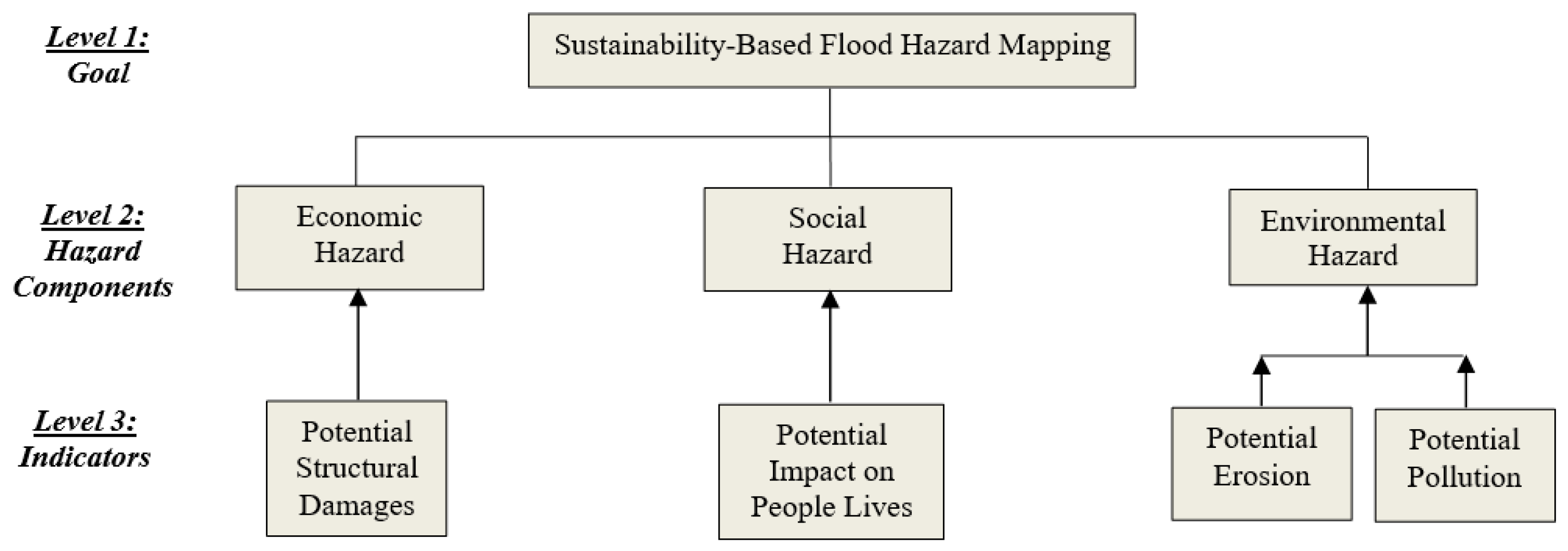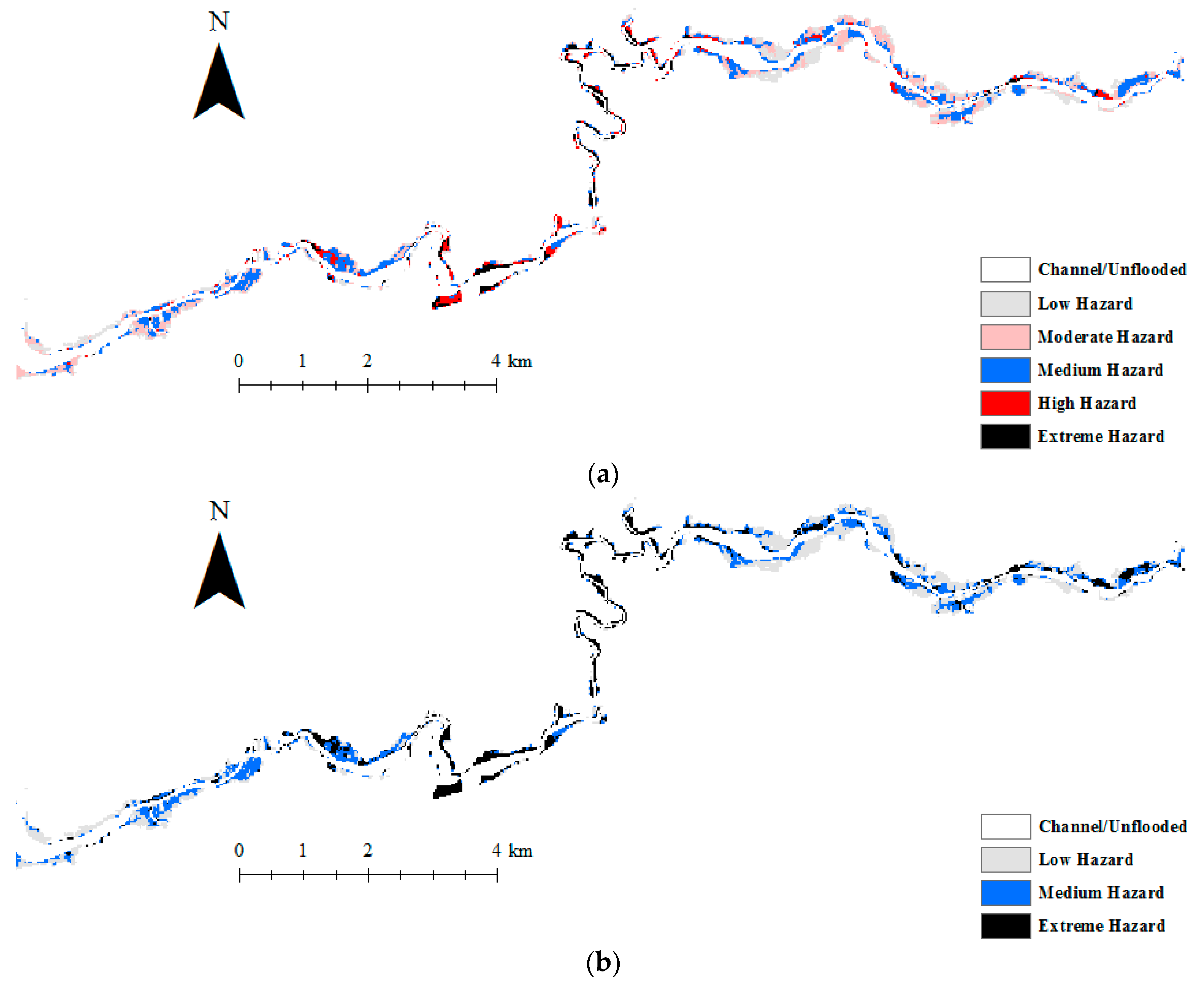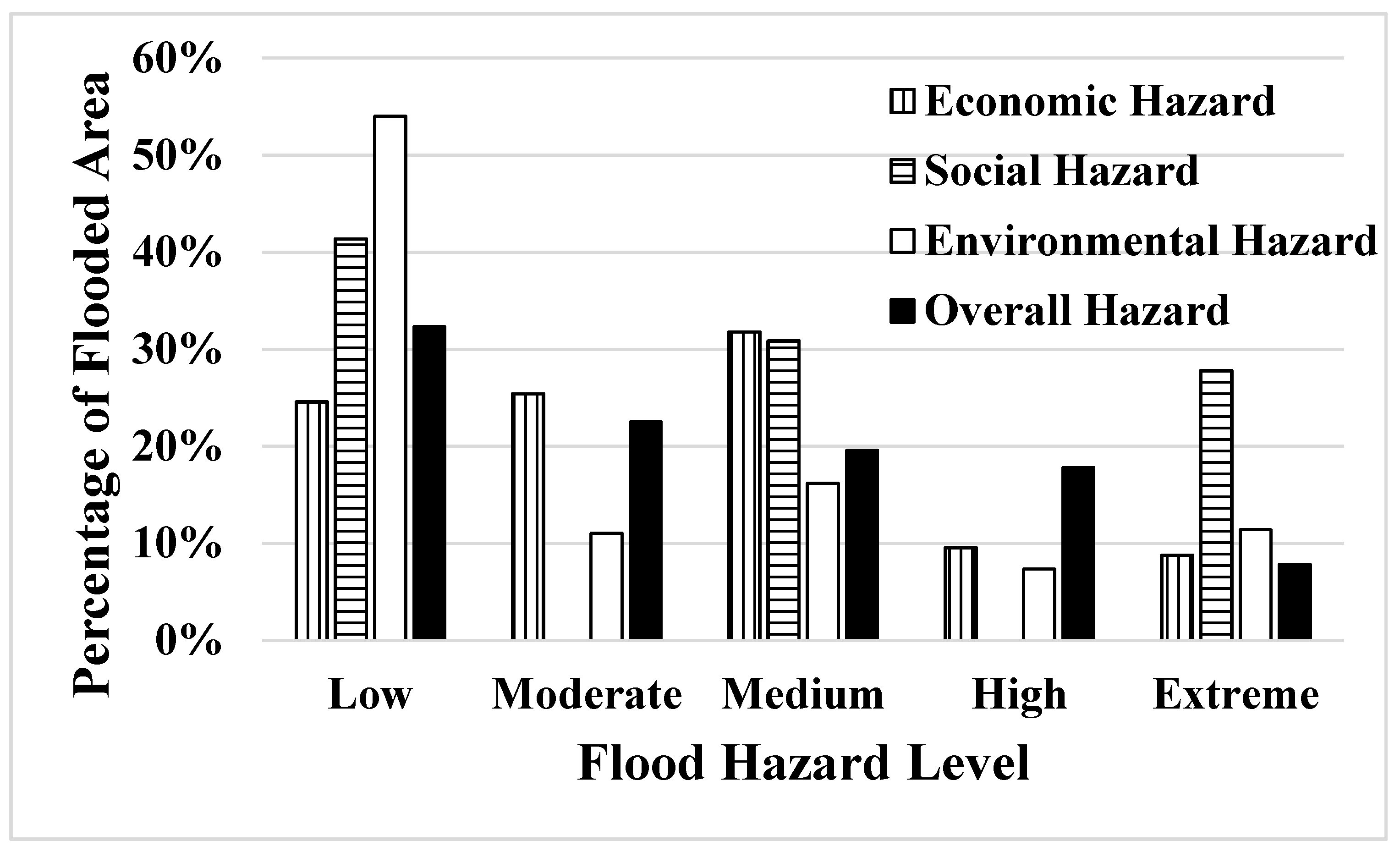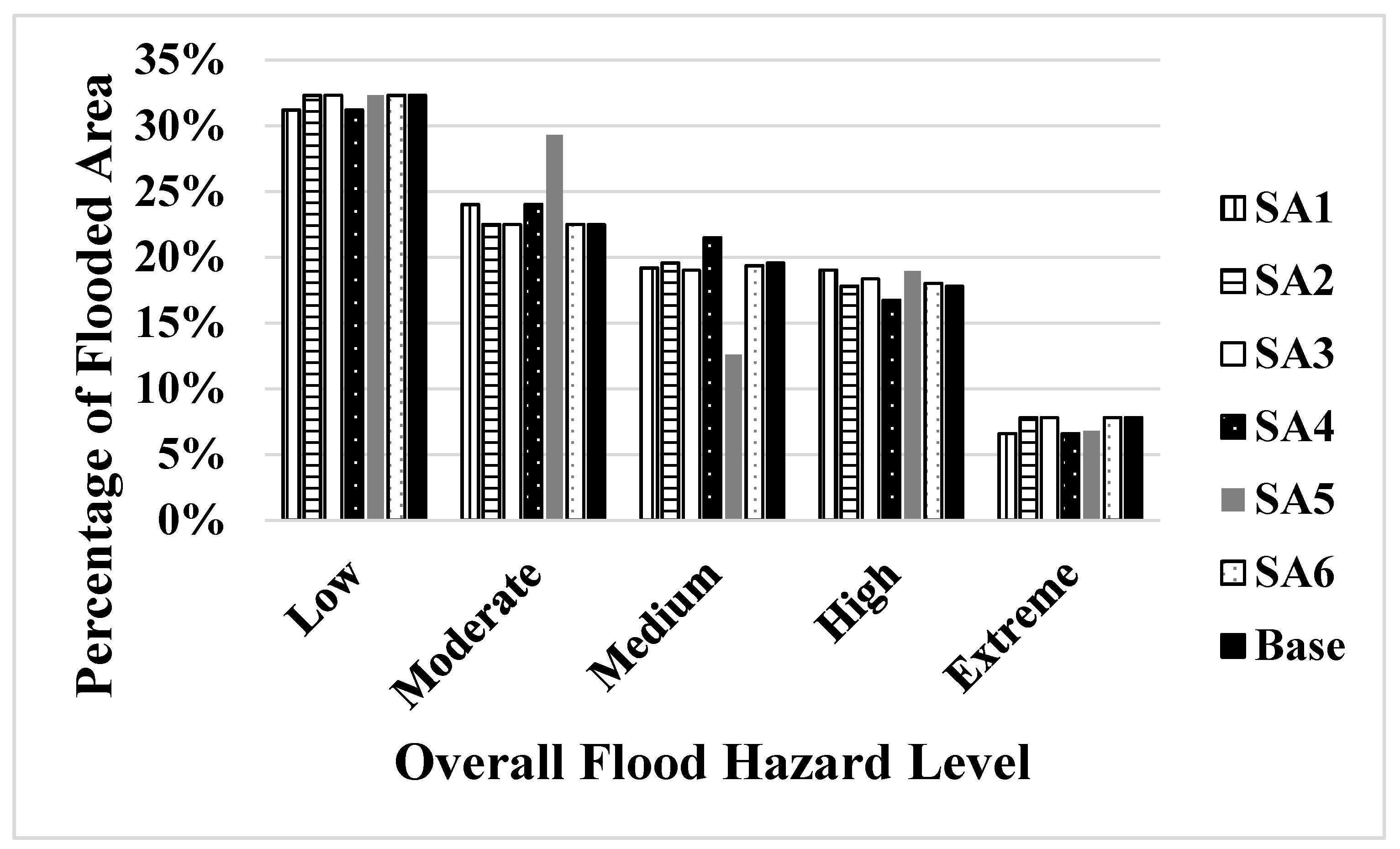Sustainability-Based Flood Hazard Mapping of the Swannanoa River Watershed
Abstract
:1. Introduction
2. Study Area
3. Methodology
3.1. Hydrologic Modeling
3.2. Hydraulic Modeling
3.3. Sustainability-Based Flood Hazard Mapping
4. Results
4.1. Hydrologic Modeling
4.2. Hydraulic Modeling
4.3. Sustainability-Based Flood Hazard Mapping
4.3.1. Survey
4.3.2. Sustainability-Based Flood Hazard Mapping
4.3.3. Sensitivity Analysis
5. Discussion
6. Summary
Acknowledgments
Author Contributions
Conflicts of Interest
References and Notes
- Levy, J.K.; Hartmann, J.; Li, K.W.; An, Y.; Asgary, A. Multi-Criteria Decision Support Systems for flood hazard mitigation and emergency response in urban watersheds. J. Am. Water Resour. Assoc. 2007, 43, 346–358. [Google Scholar] [CrossRef]
- Schröter, K.; Kreibich, H.; Vogel, K.; Riggelsen, C.; Scherbaum, F.; Merz, B. How useful are complex flood damage models? Water Resour. Res. 2014, 50, 3378–3395. [Google Scholar] [CrossRef]
- Fernandez, D.S.; Lutz, M.A. Urban flood hazard zoning in Tucumán Province, Argentina, using GIS and multicriteria decision analysis. Eng. Geol. 2010, 111, 90–98. [Google Scholar] [CrossRef]
- Kourgialas, N.N.; Karatzas, G.P. Flood management and a GIS modelling method to assess flood-hazard areas—A case study. Hydrol. Sci. J. 2011, 56, 212–225. [Google Scholar] [CrossRef]
- Papaioannou, G.; Vasiliades, L.; Loukas, A. Multi-criteria analysis framework for potential flood prone areas mapping. Water Resour. Manag. 2015, 29, 399–418. [Google Scholar] [CrossRef]
- Radmehr, A.; Araghinejad, S. Developing strategies for urban flood management of Tehran city using SMCDM and ANN. J. Comput. Civ. Eng. 2014, 28, 05014006. [Google Scholar] [CrossRef]
- Rahmati, O.; Zeinivand, H.; Besharat, M. Flood hazard zoning in Yasooj region, Iran, using GIS and multi-criteria decision analysis. Geomat. Nat. Hazards Risk 2016, 7, 1000–1017. [Google Scholar] [CrossRef]
- Stefanidis, S.; Stathis, D. Assessment of flood hazard based on natural and anthropogenic factors using analytic hierarchy process (AHP). Nat. Hazards 2013, 68, 569–585. [Google Scholar] [CrossRef]
- Kundzewicz, Z.W. Flood protection—Sustainability issues. Hydrol. Sci. J. 1999, 44, 559–571. [Google Scholar] [CrossRef]
- Kundzewicz, Z.W.; Takeuchi, K. Flood protection and management: Quo vadimus? Hydrol. Sci. J. 1999, 44, 417–432. [Google Scholar] [CrossRef]
- Carter, J.G.; White, I.; Richards, J. Sustainability appraisal and flood risk management. Environ. Impact Assess. Rev. 2009, 29, 7–14. [Google Scholar] [CrossRef]
- Ni, J.; Sun, L.; Li, T.; Huang, Z.; Borthwick, A.G. Assessment of flooding impacts in terms of sustainability in mainland China. J. Environ. Manag. 2010, 91, 1930–1942. [Google Scholar] [CrossRef] [PubMed]
- Hall, J.; Solomatine, D. A framework for uncertainty analysis in flood risk management decisions. Int. J. River Basin Manag. 2008, 6, 85–98. [Google Scholar] [CrossRef]
- Kang, M.G.; Jeong, H.S.; Lee, J.H.; Kang, B.S. Assessing national flood management using a sustainable flood management framework. Water Policy 2013, 15, 418–434. [Google Scholar] [CrossRef]
- Meyer, V.; Scheuer, S.; Haase, D. A multicriteria approach for flood risk mapping exemplified at the Muddle River, Germany. Nat. Hazards 2009, 48, 17–39. [Google Scholar] [CrossRef]
- Treby, E.J.; Clark, M.J.; Priest, S.J. Confronting flood risk: Implications for insurance and risk transfer. J. Environ. Manag. 2006, 81, 351–359. [Google Scholar] [CrossRef] [PubMed]
- Hansson, K.; Danielson, M.; Ekenberg, L.; Buurman, J. Multiple criteria decision making for flood risk management. In Integrated Catastrophe Risk Modeling: Supporting Policy and Processes; Amendola, A., Ermolieva, T., Linnerooth-Bayer, J., Mechler, R., Eds.; Springer: Dordrecht, The Netherlands, 2013; pp. 53–72. [Google Scholar]
- Lee, G.M.; Jun, K.S.; Chung, E.S. Integrated multi-criteria flood vulnerability approach using Fuzzy TOPSIS and Delphi technique. Nat. Hazards Earth Syst. Sci. 2013, 13, 1293–1312. [Google Scholar] [CrossRef]
- Akter, T.; Simonovic, S.P. Aggregation of fuzzy views of a large number of stakeholders for multi-objective flood management decision-making. J. Environ. Manag. 2005, 77, 133–143. [Google Scholar] [CrossRef] [PubMed]
- Akter, T.; Simonovic, S.P.; Salonga, J. Aggregation of inputs from stakeholders for flood management decision-making in the Red River Basin. Can. Water Resour. J. 2004, 29, 251–266. [Google Scholar] [CrossRef]
- Evers, M.; Nyberg, L. Coherence and inconsistency of European instruments for integrated river basin management. Int. J. River Basin Manag. 2013, 11, 139–152. [Google Scholar] [CrossRef]
- Kundzewicz, Z.W. Non-structural flood protection and sustainability. Water Int. 2002, 27, 3–13. [Google Scholar] [CrossRef]
- Werritty, A. Sustainable flood management: Oxymoron or new paradigm? Area 2006, 38, 16–23. [Google Scholar] [CrossRef]
- Edjossan-Sossou, A.M.; Deck, O.; Al Heib, M.; Verdel, T. A decision-support methodology for assessing the sustainability of natural risk management strategies in urban areas. Nat. Hazards Earth Syst. Sci. 2014, 14, 3207–3230. [Google Scholar] [CrossRef] [Green Version]
- Evers, M.; Jonoski, A.; Almoradie, A.; Lange, L. Collaborative decision making in sustainable flood risk management: A socio-technical approach and tools for participatory governance. Environ. Sci. Policy 2016, 55, 335–344. [Google Scholar] [CrossRef]
- U.S. Army Corps of Engineers. Swannanoa River Watershed Flood Risk Reduction Project. 2015. Available online: http://www.lrn.usace.army.mil/Media/FactSheets/FactSheetArticleView/tabid/6992/Article/562061/swannanoa-river-watershed-flood-risk-reduction-project.aspx (accessed on 1 June 2015).
- NRCS. Urban Hydrology for Small Watersheds; Technical Release 55; Conservation Engineering Division, NRCS, U.S. Department of Agriculture: Washington, DC, USA, 1986.
- U.S. Army Corps of Engineers. Method of Flow Routing; Report on Survey for Flood Control, Connecticut River Valley, Volume 1, Section 1, Appendix; Providence, RI, USA, 1936.
- Ahmadisharaf, E. A Coupled Probabilistic Hydrologic/Hydraulic Modeling Framework to Investigate the Impacts of Hydrograph Uncertainty on Flood Consequences. Ph.D. Thesis, Tennessee Technological University, Cookeville, TN, USA, 2016. [Google Scholar]
- Kalyanapu, A.J.; Shankar, S.; Pardyjak, E.R.; Judi, D.R.; Burian, S.J. Assessment of GPU computational enhancement to a 2D flood model. Environ. Model. Softw. 2011, 26, 1009–1016. [Google Scholar] [CrossRef]
- Ahmadisharaf, E.; Bhuyian, M.; Kalyanapu, A.J. Impact of spatial resolution on downstream flood hazard due to dam break events using probabilistic flood modeling. In Proceedings of the Dam Safety Conference, ASDSO, Providence, RI, USA, 8–12 September 2013; pp. 263–276. [Google Scholar]
- Kalyanapu, A.J.; Hossain, A.A.; Kim, J.; Yigzaw, W.; Hossain, F.; Shum, C.K. Toward a methodology to investigate the downstream flood hazards on the American River due to changes in probable maximum flood due to effects of artificial reservoir size and land-use/land-cover patterns. Earth Interact. 2013, 17, 1–24. [Google Scholar] [CrossRef]
- Kalyanapu, A.J.; Judi, D.R.; McPherson, T.N.; Burian, S.J. Monte Carlo-based flood modelling framework for estimating probability weighted flood risk. J. Flood Risk Manag. 2012, 5, 37–48. [Google Scholar] [CrossRef]
- Kalyanapu, A.J.; Judi, D.R.; McPherson, T.N.; Burian, S.J. Annualised risk analysis approach to recommend appropriate level of flood control: Application to Swannanoa river watershed. J. Flood Risk Manag. 2015, 8, 368–385. [Google Scholar] [CrossRef]
- Yigzaw, W.; Hossain, F.; Kalyanapu, A.J. Comparison of PMP-driven probable maximum floods with flood magnitudes due to increasingly urbanized catchment: The case of American River watershed. Earth Interact. 2013, 17, 1–15. [Google Scholar] [CrossRef]
- Graham, W.J. A Procedure for Estimating Loss of Life Caused by Dam Failure; Report No. DSO-99-06; Dam Safety Office, U.S. Bureau of Reclamation: Denver, CO, USA, 1999.
- Prinos, P.; Kortenhaus, A.; Swerpel, B.; Jimenez, J.A.; Samuels, P. Review on Flood Hazard Mapping; FLOODsite Project, Report No. T03-07-01, Revision No. 4_3_P01. 2009. Available online: http://www.floodsite.net/html/partner_area/project_docs/T03_07_01_Review_Hazard_Mapping_V4_3_P01.pdf (accessed on 16 July 2017).
- FEMA. Definitions of FEMA Flood Zone Designations. 2016. Available online: https://snmapmod.snco.us/fmm/document/fema-flood-zone-definitions.pdf (accessed on 18 January 2017).
- U.S. Army Corps of Engineers. Generic Depth-Damage Relationships for Residential Structures without Basements; Economic Guidance Memorandum, No. 1–3; 2000.
- Merz, B.; Kreibich, H.; Schwarze, R.; Thieken, A. Review article “Assessment of economic flood damage”. Nat. Hazards Earth Syst. Sci. 2010, 10, 1697–1724. [Google Scholar] [CrossRef]
- Abrishamchi, A.; Dashti, M.; Alamdari, N.; Salavitabar, A. A GIS-Google earth based approach to estimating the flood damage function in large river basins. In Proceedings of the World Environmental and Water Resources Congress, Palm Springs, CA, USA, 22–26 May 2011; pp. 3811–3821. [Google Scholar]
- Kubal, C.; Haase, D.; Meyer, V.; Scheuer, S. Integrated urban flood risk assessment–adapting a multicriteria approach to a city. Nat. Hazards Earth Syst. Sci. 2009, 9, 1881–1895. [Google Scholar] [CrossRef]
- Yang, M.; Qian, X.; Zhang, Y.; Sheng, J.; Shen, D.; Ge, Y. Spatial multicriteria decision analysis of flood risks in aging-dam management in China: A framework and case study. Int. J. Environ. Res. Public Health 2011, 8, 1368–1387. [Google Scholar] [CrossRef] [PubMed]
- ACER. Downstream Hazard Classification Guidelines; Technical Memorandum No. 11; US Bureau of Reclamation: Denver, CO, USA, 1988.
- Dang, N.M.; Babel, M.S.; Luong, H.T. Evaluation of food risk parameters in the Day River flood diversion area, Red River delta, Vietnam. Nat. Hazards 2011, 56, 169–194. [Google Scholar] [CrossRef]
- Scheuer, S.; Haase, D.; Meyer, V. Exploring multicriteria flood vulnerability by integrating economic, social and ecological dimensions of flood risk and coping capacity: From a starting point view towards an end point view of vulnerability. Nat. Hazards 2011, 58, 731–751. [Google Scholar] [CrossRef]
- Thieken, A.H.; Müller, M.; Kreibich, H.; Merz, B. Flood damage and influencing factors: New insights from the August 2002 flood in Germany. Water Resour. Res. 2005, 41, W12430. [Google Scholar] [CrossRef]
- Penning-Rowsell, E.C.; Green, C.H.; Thompson, P.M.; Coker, A.M.; Tunstall, S.M.; Richards, C.; Parker, D.J. The Economics of Coastal Management: A Manual of Benefit Assessment Techniques, 1st ed.; Belhaven Press: London, UK, 1992. [Google Scholar]
- Förster, S.; Kuhlmann, B.; Lindenschmidt, K.E.; Bronstert, A. Assessing flood risk for a rural detention area. Nat. Hazards Earth Syst. Sci. 2008, 8, 311–322. [Google Scholar] [CrossRef]
- Munda, G. Social multi-criteria evaluation for urban sustainability policies. Land Use Policy 2006, 23, 86–94. [Google Scholar] [CrossRef]
- Chen, H.; Wood, M.D.; Linstead, C.; Maltby, E. Uncertainty analysis in a GIS-based multi-criteria analysis tool for river catchment management. Environ. Model. Softw. 2011, 26, 395–405. [Google Scholar] [CrossRef]
- Evers, M.; Jonoski, A.; Lange, L.; Ochoa Rodriguez, S.; Teklesadik, A.; Cortes Arevalo, J.; Almoradie, A.; Eduardo Simoes, N.; Wang, L.; Makropoulos, C. Collaborative modelling for active involvement of stakeholders in urban flood risk management. Nat. Hazards Earth Syst. Sci. 2012, 12, 2821–2842. [Google Scholar] [CrossRef]
- Challies, E.; Newig, J.; Thaler, T.; Kochskämper, E.; Levin-Keitel, M. Participatory and collaborative governance for sustainable flood risk management: An emerging research agenda. Environ. Sci. Policy 2016, 55, 275–280. [Google Scholar] [CrossRef]
- Kodikara, P.N.; Perera, B.J.C.; Kularathna, M.D.U.P. Stakeholder preference elicitation and modelling in multi-criteria decision analysis–A case study on urban water supply. Eur. J. Oper. Res. 2010, 206, 209–220. [Google Scholar] [CrossRef]
- Keller, G. Statistics for Management and Economics, 9th ed.; South-Western Cengage Learning: Mason, OH, USA, 2012. [Google Scholar]
- Ahmadisharaf, E.; Tajrishy, M.; Alamdari, N. Integrating flood hazard into site selection of detention basins using spatial multi-criteria decision-making. J. Environ. Plan. Manag. 2016, 59, 1397–1417. [Google Scholar] [CrossRef]
- Horritt, M.S. Calibration of a two-dimensional finite element flood flow model using satellite radar imagery. Water Resour. Res. 2000, 36, 3279–3291. [Google Scholar] [CrossRef]
- Horritt, M.S.; Bates, P.D. Predicting floodplain inundation: Raster-based modelling versus the finite-element approach. Hydrol. Process. 2001, 15, 825–842. [Google Scholar] [CrossRef]
- Bonnin, G.M.; Martin, D.; Lin, B.; Parzybok, T.; Yekta, M.; Riley, D. Precipitation frequency Atlas of the United States; NOAA Atlas 14, Volume 2, Version 3.0; National Weather Service, NOAA: Silver Spring, MD, USA, 2006.
- Ahmadisharaf, E.; Kalyanapu, A.J.; Chung, E.S. Evaluating the effects of inundation duration and velocity on selection of flood management alternatives using multi-criteria decision making. Water Resour. Manag. 2015, 29, 2543–2561. [Google Scholar] [CrossRef]
- Asadabadi, A.; Miller-Hooks, E. Assessing strategies for protecting transportation infrastructure from an uncertain climate future. Transp. Res. Part A Policy Pract. 2017, 105, 27–41. [Google Scholar] [CrossRef]
- Kreibich, H.; Piroth, K.; Seifert, I.; Maiwald, H.; Kunert, U.; Schwarz, J.; Merz, B.; Thieken, A.H. Is flow velocity a significant parameter in flood damage modelling? Nat. Hazards Earth Syst. Sci. 2009, 9, 1679–1692. [Google Scholar] [CrossRef]
- Knight, F.H. Risk, Uncertainty, and Profit; Hart, Schaffner and Marx: New York, NY, USA, 1921. [Google Scholar]
- Merwade, V.; Olivera, F.; Arabi, M.; Edleman, S. Uncertainty in flood inundation mapping: Current issues and future directions. J. Hydrol. Eng. 2008, 13, 608–620. [Google Scholar] [CrossRef]
- Pappenberger, F.; Matgen, P.; Beven, K.J.; Henry, J.B.; Pfister, L. Influence of uncertain boundary conditions and model structure on flood inundation predictions. Adv. Water Resour. 2006, 29, 1430–1449. [Google Scholar] [CrossRef]
- Smemoe, C.M.; Nelson, E.J.; Zundel, A.K.; Miller, A.W. Demonstrating floodplain uncertainty using flood probability maps. J. Am. Water Resour. Assoc. 2007, 43, 359–371. [Google Scholar] [CrossRef]
- Gilroy, K.L.; McCuen, R.H. A nonstationary flood frequency analysis method to adjust for future climate change and urbanization. J. Hydrol. 2012, 414–415, 40–48. [Google Scholar] [CrossRef]
- Hirabayashi, Y.; Mahendran, R.; Koirala, S.; Konoshima, L.; Yamazaki, D.; Watanabe, S.; Kim, H.; Kanae, S. Global flood risk under climate change. Nat. Clim. Chang. 2013, 3, 816–821. [Google Scholar] [CrossRef]
- Nazari, B.; Seo, D.J.; Muttiah, R. Assessing the impact of variations in hydrologic, hydraulic and hydrometeorological controls on inundation in urban areas. J. Water Manag. Model. 2016. [Google Scholar] [CrossRef]
- Ahmadisharaf, E.; Kalyanapu, A.J.; Chung, E.S. Spatial probabilistic multi-criteria decision making for assessment of flood management alternatives. J. Hydrol. 2016, 533, 365–378. [Google Scholar] [CrossRef]
- Pappenberger, F.; Stephens, E.; Thielen, J.; Salamon, P.; Demeritt, D.; vanAndel, S.J.; Watterhall, F.; Alfieri, L. Visualizing probabilistic flood forecast information: Expert preferences and perceptions of best practice in uncertainty communication. Hydrol. Process. 2013, 27, 132–146. [Google Scholar] [CrossRef]
- Rosner, A.; Vogel, R.M.; Kirshen, P.H. A risk-based approach to flood management decisions in a nonstationary world. Water Resour. Res. 2014, 50, 1928–1942. [Google Scholar] [CrossRef]








| Flood Hazard Component | Indicator | Flood Parameter | Class | Score |
|---|---|---|---|---|
| <0.5 m | 0.1 | |||
| 0.5 m–1 m | 0.3 | |||
| Economic Hazard | Structural Damages | Depth | 1.0 m–2.0 m | 0.5 |
| 2.0 m–3.0 m | 0.7 | |||
| >3.0 m | 0.9 | |||
| Low-Danger | 0.1 | |||
| Social Hazard | People Lives | Depth and Velocity | Judgment Zone * | 0.5 |
| High-Danger | 0.9 | |||
| Environmental Hazard | <1 m2/s | 0.1 | ||
| 1 m2/s–2 m2/s | 0.3 | |||
| Potential Erosion | Impulse | 2 m2/s–3 m2/s | 0.5 | |
| 3 m2/s–7 m2/s | 0.7 | |||
| >7 m2/s | 0.9 | |||
| <1 day | 0.1 | |||
| 1 day–2 days | 0.3 | |||
| Pollution | Duration | 2 days–3 days | 0.5 | |
| 3 days–5 days | 0.7 | |||
| >5 days | 0.9 |
| Overall Hazard | 0.0–0.2 | 0.2–0.4 | 0.4–0.6 | 0.6–0.8 | 0.8–1.0 |
|---|---|---|---|---|---|
| Hazard Level | Low Hazard | Moderate Hazard | Medium Hazard | High Hazard | Extreme Hazard |
| Component | Economic Hazard | Social Hazard | Environmental Hazard | |
|---|---|---|---|---|
| Scenario | ||||
| Initial | 0.333 | 0.360 | 0.304 | |
| SA1 | 0.367 | 0.345 | 0.288 | |
| SA2 | 0.300 | 0.378 | 0.322 | |
| SA3 | 0.317 | 0.396 | 0.287 | |
| SA4 | 0.353 | 0.324 | 0.323 | |
| SA5 | 0.319 | 0.346 | 0.334 | |
| SA6 | 0.350 | 0.377 | 0.273 | |
© 2017 by the authors. Licensee MDPI, Basel, Switzerland. This article is an open access article distributed under the terms and conditions of the Creative Commons Attribution (CC BY) license (http://creativecommons.org/licenses/by/4.0/).
Share and Cite
Ahmadisharaf, E.; Kalyanapu, A.J.; Chung, E.-S. Sustainability-Based Flood Hazard Mapping of the Swannanoa River Watershed. Sustainability 2017, 9, 1735. https://doi.org/10.3390/su9101735
Ahmadisharaf E, Kalyanapu AJ, Chung E-S. Sustainability-Based Flood Hazard Mapping of the Swannanoa River Watershed. Sustainability. 2017; 9(10):1735. https://doi.org/10.3390/su9101735
Chicago/Turabian StyleAhmadisharaf, Ebrahim, Alfred J. Kalyanapu, and Eun-Sung Chung. 2017. "Sustainability-Based Flood Hazard Mapping of the Swannanoa River Watershed" Sustainability 9, no. 10: 1735. https://doi.org/10.3390/su9101735





